- Home
- Works in Exhibitions
- Fridel Dethleffs-Edelmann
- Ursula Dethleffs
- Treasures from the Collection
- Collection of art
- Watercolor
- Tapestry
- Collage
- Gouache
- Reverse glass painting
- Glass church window
- Glass Mosaic
- Ceramic Plate
- Ceramic Picture
- Ceramic Relief
- Ceramic Sculpture
- Mixed media
- Object Art Relief
- Object Art Sculpture
- Oil Paintings
- Repro Lithography
- Repro Glass Lithography
- Repro Woodcut
- Repro Linocut
- Repro Monotype Printing
- Repro Etching
- Tempera
- Drawing Brush
- Drawing Brush Repro
- Drawing Ink and Pen
- Drawing Crayon
- Drawing pencil and crayon
- Exhibition by Period
- FDE: Selfportraits
- Introduction to the work of Ursula Dethleffs
- The collage as a total artwork
- Biography
- Dethleffs Gallery
einzigartig
Fridel Dethleffs-Edelmann
Ursula Dethleffs
Fridel Dethleffs-Edelmann
Ursula Dethleffs


Ursula Dethleffs:
Issued for the first time: 150 of their most significant works
Her works were selected by three art historians: Dr. U. Merkel, Dr. M. Scholl and Mrs. S.Bieber (M.A.) from Karlsruhe.
At the Baden State Art School in Karlsruhe, Ursula's mother was one of the first students of the "New Objectivity" to be introduced to art. Her most famous painting "Self-Portrait in the Paint Shop" (Works Directory 152100) is honored as a model of German Classicism between 1918 and 1936 in many museums. In addition to her own path, Fridel Dethleffs-Edelmann has given artistic freedom to her daughter as her art teacher. Ursula Dethleffs was able to artistically find her own way unmolested by the ups and downs of the art fashions: Initially, the mother led her daughter over traditional tapestries, watercolors, glass paintings and ceramics. Very early Ursula Dethleffs has turned to her own art language: transformation of seemingly worthless to new, timeless, artistic power. The materials chosen by Ursula corresponded to the Swabian thriftiness in the post-war period against the overflowing throw-away society. For Ursula, however, this was not a profession of faith, because the whole family was thrifty. Today it is different. You can buy what you need. Everything was valuable then - even the old. You could buy almost nothing. But the young Ursula could go to relatives and ask for old pieces of paper - for her first drawings, later for collages. Or she charmed the carpenter who had picked up old windows with old glass in the back of the workshop - for small reverse glass paintings. Or shingles later for a witch. Scraps of cloth she found at the aunts, cloth shops or seamstresses for their tapestries. Everything she found, whether with relatives, craftsmen or on beaches - wherever: Ursula collected everything. Hardly anyone could feel how the old things could fertilize their imagination, their creativity. Because the collection result did not look like art in the studio Dethleffs:
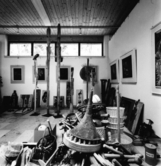
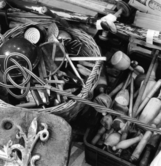
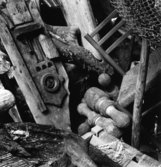
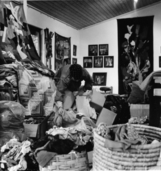
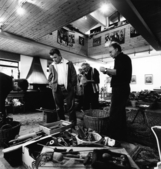
The mockery of the philistine was Ursula sure: The sheltered factory daughter could allegedly not stop collecting old "scare". No wonder that the girl, who had originally been celebrated as a prodigy, was soon denounced as the "scrap ballet".This could hurt Ursula and sabotage her success.
The fact, that she had replaced the objects but her passion for collecting in the meantime was noticed only by her friends and acquaintances. In the meantime, for example, she was also looking for precious scraps of fabric for her tapestries, which were no longer big enough for an altar quilt. Above all, she searched for and bought antiques everywhere: she used antique parts to enhance her works of art almost unnoticed.
"Almost unnoticed" was a typically female character trait of the artist. An artist would have made a show of it: "look what superman I am". That was not the style of Ursula Dethleffs. She could also have drastically increased the prices of her artworks. Thrift was no longer a virtue after 1960, at best a petty secondary virtue. Low prices damaged the appreciation of their works.
Self-recognized art connoisseurs wanted to dominate mother and daughter: the mother should leave the New Objectivity to glorify the Nazis with "German Art". (Her oil painting "Selbst mit Tochter" WVZ No. 152201 shows the dubious success of this experiment.) Of the daughter Ursula many wished that they can find their way back to the enchanting beauty of their early works from archaic object art. The two artists were put in the way, they went their own way together.That was the secret of the bond between mother and daughter, which hardly anyone understood.
And the artistic difference between mother and daughter? It becomes clear when you look at the 5 decades in a row:
1940 -1949: thirty best works of the young Ursula in nine different techniques - including 6 x watercolor / gouache, 5 x behind glass, 5 x drawing, 4 x tapestry, 4 x lithographs, 4 x woodcut.
1950 - 1959: thirty-five best works in five different techniques - of which 11 x ceramics, 9 drawings, 6 x wood and linocut, 5 x etching, 3 x collage.
1960 -1961: thirty-four best works in seven different techniques - including 16 x ceramic, 6 x collage, 5 x tapestry, etc. (new technique monotype).
1970 - 1979: Twenty-nine best works in six different techniques - including 9 ceramics, 8 tapestries, 5 x behind glass with 3 windows in the Nikolaikirche Isny etc.
1980 - 1994: twenty-four best works in four different techniques with 14 x object art, 5 x tapestry, etc.
This surprising variety is the result of the fact that Ursula was not trained at an art academy but by her mother and many of the family's artistic friends. Ursula was allowed to develop freely from the beginning. As an art teacher, the mother was always strict, but never dominant. That's why she was worshiped by Ursula until her death.
The art historians U. Merkel, dr. M. Scholl and Mrs. Beaver (B.A.) have opened our eyes. I am grateful for that!
Bernd Riedle in September 2019